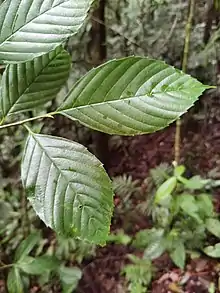| Ticodendron | |
|---|---|
 | |
| Scientific classification | |
| Kingdom: | Plantae |
| Clade: | Tracheophytes |
| Clade: | Angiosperms |
| Clade: | Eudicots |
| Clade: | Rosids |
| Order: | Fagales |
| Family: | Ticodendraceae Gómez-Laur. & L.D.Gómez[2] |
| Genus: | Ticodendron Gómez-Laur. & L.D.Gómez |
| Species: | T. incognitum |
| Binomial name | |
| Ticodendron incognitum Gómez-Laur. & L.D.Gómez | |
Ticodendron incognitum is the only species of Ticodendron, and the only member of the family Ticodendraceae. It is most closely related to the family Betulaceae.
It was discovered only in 1989 in Costa Rica, having been overlooked previously due to its habitat in poorly researched cloud forests and its very 'ordinary' appearance; further research showed its range extends from southern Mexico (Veracruz, Oaxaca, Chiapas), south through Central America to Panama.[3][4][5][6]
It is a tree, 20–30 m tall, superficially resembling an alder in appearance, with alternate, simple leaves 5–12 cm long with a serrated margin. It is generally dioecious, with separate male and female plants.[7]
Fossil record
†Ferrignocarpus bivalvis fossil fruits, from the Middle Eocene of Oregon and the Early Eocene London Clay flora of southern England, correspond closely in morphology and anatomy to fruits of extant Ticodendron.[8]
References
- ↑ Rivers, M.C.; Barstow, M.; Fuentes, A.C.D. (2019). "Ticodendron incognitum". IUCN Red List of Threatened Species. 2019: e.T37468A128258819. doi:10.2305/IUCN.UK.2019-3.RLTS.T37468A128258819.en. Retrieved 11 November 2021.
- ↑ Angiosperm Phylogeny Group (2009). "An update of the Angiosperm Phylogeny Group classification for the orders and families of flowering plants: APG III". Botanical Journal of the Linnean Society. 161 (2): 105–121. doi:10.1111/j.1095-8339.2009.00996.x.
- ↑ Kew Checklist of Selected Plant Families
- ↑ Nelson Sutherland, C.H. (2008). Catálogo de las plantes vasculares de Honduras. Espermatofitas: 1-1576. SERNA/Guaymuras, Tegucigalpa, Honduras.
- ↑ Gómez-Laurito, Jorge & Gómez P., Luis Diego 1989. Ticodendron: A new tree from Central America. Annals of Missouri Botanical Garden 76(4): 1148–1151
- ↑ Ulloa Ulloa, C. 2001. Ticodendraceae. En: Stevens, W.D., C. Ulloa, A. Pool & O.M. Montiel (eds.). Flora de Nicaragua. Monographs in systematic botany from the Missouri Botanical Garden 85(3): 2452
- ↑ Kubitzki, K. (1993). "Ticodendraceae". Flowering Plants · Dicotyledons. pp. 594–596. doi:10.1007/978-3-662-02899-5_72. ISBN 978-3-642-08141-5.
- ↑ Manchester, Steven R. (November 2011). "Fruits of Ticodendraceae (Fagales) from the Eocene of Europe and North America". International Journal of Plant Sciences. 172 (9): 1179–87. doi:10.1086/662135. S2CID 84609421.
External links
- Photo of leaves and fruit Archived 2010-08-07 at the Wayback Machine
- Photo of herbarium specimen Archived 2011-05-25 at the Wayback Machine
- Distribution map
- Neotropical Plant Families Database @ www.lacistemataceae.org/NPFD Archived 2011-10-04 at the Wayback Machine
